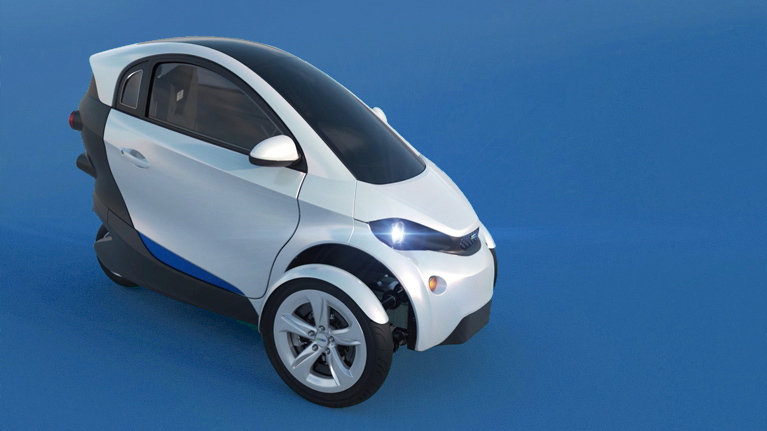An efficient, sustainable and innovative three-wheeled vehicle
Developing an electric vehicle based on a compact design that is as comfortable and safe as a conventional car.

Pollution and traffic jams are nowadays the two biggest problems with regard to issues such as quality of life and health in urban areas. Consequently, the progressive electrification of vehicles not only an efficient alternative but also a major challenge.
It is in this context that the Tekniker technology centre, member of the Basque Research and Technology Alliance (BRTA), has coordinated the production of an innovative prototype for a three-wheeled electric vehicle featuring a compact design that provides the comfort of a conventional car according to efficiency and sustainability parameters.
The prototype itself, called WEEVIL, brings together a number of elements that will allow this vehicle to become a landmark in the electric vehicle sector thanks to a mechanism called PINCER that is installed on the front axle to provide greater stability, without the characteristic tilt of two-wheeled vehicles, and also reduce its size when parking and to a modular system with interchangeable batteries that increases range and service life. The vehicle has also been equipped with a lighter and safer chassis to better cope with collisions and a new electric motor concept that is both compact and efficient.
The WEEVIL project is the end result of work carried out done by a consortium of eight companies and technology centres from different countries under the umbrella of the European Horizon 2020 project whose ultimate goal is to develop an encapsulated electri urban vehicle with two wheels at the front and only one at the back.
Tekniker’s role in this project has addressed three areas: designing a new compact and efficient electric motor, developing PINCER and coordinating the work done by all the other partners involved in this initiative.
“As compact as a motorbike and as safe as a car”
Compared to cars, “WEEVIL is a vehicle that offers the same degree of comfort and safety, although it is actually based on the compact design of a motorcycle”, says Imanol Egaña, a Tekniker researcher and project coordinator.
The prototype, with a budget of more than 6 million euros, is a 1+1 vehicle, with enough room for two people travelling simultaneously, one of them driving and the other sitting in the back, and whose front axle has been equipped with the so-called PINCER (ParkINg Cross-distance Adaptator) system. This system, on the one hand, allows the driver the possibility of increasing the separation between both wheels to provide the degree of stability required for driving, and, on the other, the option of reducing axle width to reduce the amount of parking space required. The vehicle has been equipped with a joystick in the back so it can be parked from outside in a comfortable and effortless manner, even when there is not enough space to open the door and alight from the vehicle or board it.
An “interchangeable battery technology”
This prototype boasts another differential element thanks to its modular battery system equipped with standardised interfaces. This solution allows users to adapt the vehicle to their specific needs and also incorporate future developments that will serve to improve range, service life, etc.
As explained by Egaña, “nowadays, battery technologies are evolving and improving year after year and the fact of having modular battery bundles with standard interfaces will mean that WEEVIL will be able to incorporate new batteries without any problems whatsoever and improve performance in terms of extended range, longer service life, shorter recharging times and less weight”.
A safer chassis
In terms of safety, moreover, this prototype has been equipped with a chassis designed to absorb a greater amount of impact energy without collapsing. The cabin is fully enclosed and the amount of space available for both occupants is similar to what cars offer. This vehicle has been fitted with a safety belt and a seat with a backrest. It is unnecessary, moreover, to wear a helmet.
The chassis is made of glass fibre reinforced polymers (GFRP) because these materials can reduce the weight of the chassis by up to 70% and, compared to metals, they dissipate five times more impact energy. Although they provide a suitable alternative in terms of road safety and energy efficiency, composite materials are expensive because they require complex manufacturing processes. Consequently, one of the project’s goals has consisted in finding affordable manufacturing alternatives. The end result of these efforts has resulted in a more efficient cured pultrusion process that used UV rays and allows profiles to be moulded before being hardened. Costs are lower, too, as the system uses a smaller and more simple die.
A more efficient motor with no permanent magnets
As regards traction, an efficient motor without magnets has been designed that comprises the electric machine, the gearbox and an electronic converter. The option chosen is a technology based on switched magnetic reluctance instead of rare earth permanent magnets. Motors of this kind deliver enhanced average performance levels through the entire speed range.
Driving tests carried out on this prototype have produced positive results in terms of comfort and ergonomy. The vehicle is also based on a design and components already available on the market that meet all applicable European standards and can be obtained via the current supply chain.
The electric motor will be presented at the second edition of the Go Mobility trade fair on mobility and power storage that will take place on March 11-12 at the Ficoba Exhibition Centre in Irun (Gipuzkoa).
This Project has received funding from the European Union’s Horizon 2020 research and innovation programme under grant agreement No. 653926.
